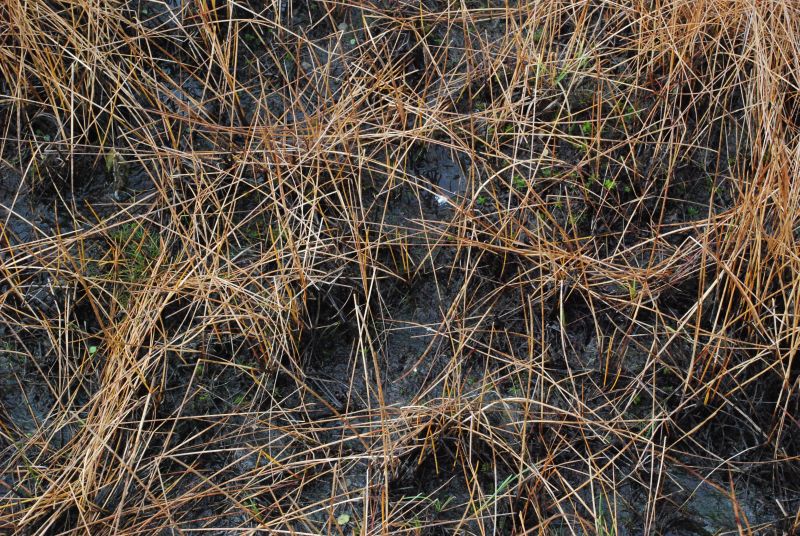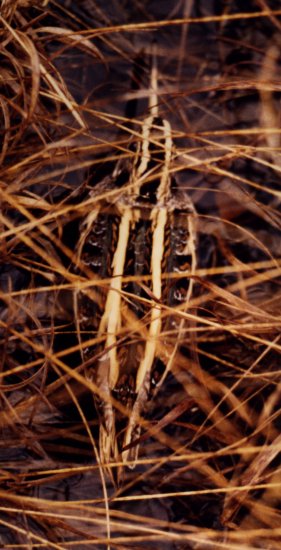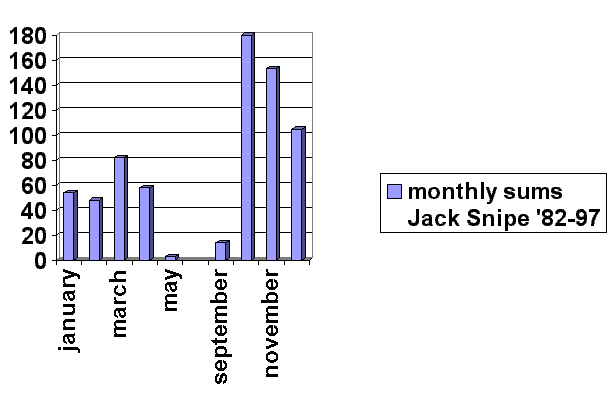The Jack Snipe (Lymnocryptes
minimus)
Introduction
A lot of birdwatchers don't observe the Jack Snipe
annual. During my research in the "Bergvennen"
(near Denekamp in the Netherlands) I've had the opportunity
to study unusually large numbers : over 1000 (period
1982-2007). Most of them were here during migration, but there were also
significant numbers of wintering birds. Though the main goal in this area was
to study the general bird-population I concentrated my effort in wintertime on
this species. I will therefore describe the habitat, the behaviour and the
numbers of the Jack Snipe in this area outside the breeding season.
Search method
Normally I visit the study-area every other week.
Outside the breeding season I will take into account changes of weather. During
periods of cold, icy weather or long droughts there are less visits. Sudden
rainfall can inspire a visit. The Jack Snipe , being a
species hard to observe in its habitat, deserves a special strategy.
There are two ways:
* In the company of some fellow-bird-watchers I cover
a wide area just by walking with some meters distance between us.
* Being alone I walk a kind of "zigzag-run", regularly going back.
This rather intensive method of covering the area is a reason to limit my
visits in the area. Patiently waiting till the bird leaves coverage is of no
use here.
Habitat
The Jack Snipe relies rightly on its cryptic colour. It is quite normal to find
a Jack Snipe next to a footpath, while the Snipe leaves at the first sight of a
visitor. The Jack Snipe prefers coverage that is scattered: a bit of reed,
small tussocks, preferably badly developed vegetation Here
they also look for food on a mostly muddy soil, sometimes a bit mossy.

The
availability of food is dependent on the water-level. I assume that Jack Snipe
and Snipe look for the same kind of food. When a small lake dries up, the Snipe
with its longer beak can still reach for some food. Then the Jack Snipe tries
its luck near small tussocks and footprints (mostly mine !).
In the latter you can sometimes find 15-20 needle-holes as if some
sewing-machine did its work. When the water-level rises the Snipe will stay
longer because of its longer legs. In other words the Jack Snipe is more
critical in this respect. In my research the Snipe is indeed more numerous in
times of rainy weather; on the other hand the Jack Snipe will endure longer
when the winter starts to influence the circumstances. After the retreat of a
short wintry period the Jack Snipe will soon return, the first Snipes being
quite later.
In the Bergvennen the Jack Snipe is normally more
numerous, the record being 32 birds on the 5-th of October 1989 on an area of about
100 sqm !
In the nearby flood-area of a German sewer-field the Snipe is far more
numerous. In this area there is less coverage, the water is eutrofic
and less acid. It is not clear to me whether the low pH of the water in the Bergvennen influences the food of the Jack Snipe. Some
years ago there was a restoration of the area in favour of the important
vegetation: Lobelia dortmanna, Littorella
uniflora. The favourite refuge of the Jack Snipe was
not included, when the upper layer of the area was removed. It is therefore now
a true Jack Snipe -reserve.
In the Baltic countries (and perhaps other ?) it
occurs on meadows, partially covered with manure. When this has done its work,
it becomes attractive for Jack Snipe. Other habitats in the Netherlands, known
to me, are: the shores of lightly acid lakes (Veluwe),
badly developed reed near lakes, even arid areas (!,
dunes Terschelling, Spain), partially flooded areas
(by the sea, Terschelling).
Behaviour
 Jack Snipes normally flee
individually when disturbed, even when there are more than 10 birds present.
Although the group as such could be called a flock they react as a single bird.
Other waders fly off in groups. The Jack Snipe doesn't consider the flight of
its neighbours as a signal of immediate danger, but will become alert. What I
did observe several times is the retreat under tussocks. You will find little
pieces of shit near tussocks and when you are very lucky you can see the bird
sitting below. Because my research area is covered with all sorts of vegetation
I succeeded to watch only 1 % of the birds freezing in a horizontal position
(cf. Bittern).
Jack Snipes normally flee
individually when disturbed, even when there are more than 10 birds present.
Although the group as such could be called a flock they react as a single bird.
Other waders fly off in groups. The Jack Snipe doesn't consider the flight of
its neighbours as a signal of immediate danger, but will become alert. What I
did observe several times is the retreat under tussocks. You will find little
pieces of shit near tussocks and when you are very lucky you can see the bird
sitting below. Because my research area is covered with all sorts of vegetation
I succeeded to watch only 1 % of the birds freezing in a horizontal position
(cf. Bittern).
By doing so the stripes of the back and the head form long lines, very much
alike dry grass (see picture). The bird will remain so despite curious gazing
birdwatchers. You can watch the bird breathing and sometimes "wave" a
bit, as if moved by the wind: mimicry ? In all cases I
was the one that retreated ! Sometimes this fine bird
is the victim of its excellent performance: I found three times the remains of
a Jack Snipe. I myself had the bad luck of killing a bird with my boot. I
suppose there also some victims due to reed-cutting.
In most cases the bird flees silently, but about 10% of them utters a soft
croak, after being disturbed. The Snipe calls more immediate and louder.
Though I didn't keep good records on this issue I get the impression
that particularly birds belonging to a flock (over 10 ) are calling; being
rather "on their own" they are yet warning their companions (?). The
percentage of calling birds in flocks over 10 is about 20% while single birds
and small flocks (up to 5) usually remain silent. While the bird is flying up
you have enough characteristics to discern it from the Snipe:
1. in small flocks the birds are silent, while the Snipe has a very distinct
repeated call.
2. the proportion beak-length/ head-length; with the
Snipe the beak is clearly longer, not in the Jack Snipe.
3. it flies in a long curve, landing after 50-70
meters, while the Snipes rises steeper with fast hooks and leaves the area ,
its wingbeats are more powerful. A Jack Snipe which was already disturbed flees
sooner the second time!
Seasonal variation
I will deal with the numbers in the Bergvennen now.
In this part of Europe the Jack Snipe migrates on a broad front. Sometimes
concentrations of birds will occur due to persistent easterly winds: there are
"good" and "bad" years, but I am no
sure whether this is the consequence of these winds alone. The availability of
suitable habitat seems of more influence (see below) In an average year the
first birds arrive here in the latter half of September and leave the area in
the second half of April, some late birds first week of May. The diagram below
is based on my research during the period 1982-1997 with over 600 counted birds.

Comment with this diagram
1. The migration in the fall starts in September, reaches its peak in October;
November shows sometimes great numbers.
2. In a mild winter a small number of birds stays in the area.
3. Migration in spring is less conspicuous than in fall.
4. There are some details to be mentioned. In some years there was an influx of
snow and ice during December and also in February. In these winters the numbers
are decreasing rapidly, after which there is a small number of returning birds.
During short periods of ice and snow the birds persist along small ditches with
running water. This seems to be the same kind of behaviour as in the Shetlands
where birds during snowy periods flee towards the coast. When the thaw sets in
after a longer period of very cold weather it takes a few weeks before they
have returned. Obviously they have left the country permanently.
5. In times of rain and rising water-levels the Jack Snipe leaves the Bergvennen. The area itself has become less suitable for
the short-legged birds and there is now a fast choice of habitat in wet
meadows.
Longterm developments (added february 2017)
During the
period 1982-2017 Over 1100 Jack Snipes
were counted in the Bergvennen by me. Therefore it is possible to draw some conclusions about longterm developments. This is however only possible fort the period after
the changes of 1993/94, when important parts of the
habitat were lost. Generally speaking the migratory population
in the Bergvennen is stable,
with some variation due to
waterlevel and temperature.
General Conclusions
1. The Jack Snipe relies very much on its cover and will, when disturbed,
seldom warn its "fellow-travellers".
2. As a consequence of 1. they normally fly up single.
3. When the bird notices a birdwatcher (e.g.) it will stop feeding, looking for
cover and freeze.
4. The Jack Snipe prefers habitats which form a transition between wet and dry
areas, the shores of lakes, drying up of small ponds, wet
terrain after a rainfall.
5. In mild winters the birds stay in this reserve.
6. The bird is very flexible in its attitude towards the weather, always
prepared to change the location.
Literature, which I consulted
· Nothing in particular, only the great works, like the Birds of the WP and the
Handbuch der VM
· Some useful reactions by E-mail
Harm A. Meek
De Plevier 7
7591 JJ Denekamp
the Netherlands
tel.(0)541-353095
meek@xs4all.nl